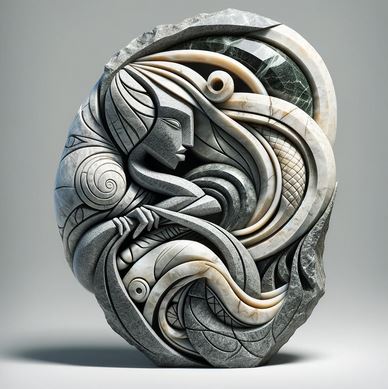Shona sculpture is a contemporary art movement that originated in Zimbabwe, Africa. It is characterized by stone carvings made by the Shona people, who are renowned for their craftsmanship and creativity. The sculptures are made from various types of stones, including soapstone, serpentine, and verdite. Shona sculpture is a powerful visual language that represents the cultural heritage of the Shona people, their beliefs, and their way of life.

The image above was contributed by Chatgpt4. It offers a modern interpretation of a Shona sculpture from Zimbabwe. This version blends traditional and contemporary artistic styles, crafted by a talented Shona artist using soapstone, serpentine, and verdite. The sculpture symbolizes the dynamic cultural identity of the Shona people, merging ancestral traditions with modern perspectives.
offering a modern interpretation of a Shona sculpture from Zimbabwe. This version blends traditional and contemporary artistic styles, crafted by a talented Shona artist using soapstone, serpentine, and verdite. The sculpture symbolizes the dynamic cultural identity of the Shona people, merging ancestral traditions with modern perspectives.
offering a modern interpretation of a Shona sculpture from Zimbabwe. This version blends traditional and contemporary artistic styles, crafted by a talented Shona artist using soapstone, serpentine, and verdite. The sculpture symbolizes the dynamic cultural identity of the Shona people, merging ancestral traditions with modern perspectives.
offering a modern interpretation of a Shona sculpture from Zimbabwe. This version blends traditional and contemporary artistic styles, crafted by a talented Shona artist using soapstone, serpentine, and verdite. The sculpture symbolizes the dynamic cultural identity of the Shona people, merging ancestral traditions with modern perspectives.
History Close me - Funga ndini
The history of modern Shona sculpture can be traced back to the 1950s, when a group of missionaries encouraged the Shona people to develop their artistic skills. The first stone sculptures were simple in form and depicted animals and human figures. However, as the movement grew, so did the complexity of the sculptures. Today, Shona sculpture is recognized as one of the most important art forms to come out of Africa in the 20th century.
Tools Close me - Funga ndini
The tools used in Shona sculpture are basic and traditional. They include chisels, hammers, and rasps. The sculptors use these tools to create intricate details and textures in the stone. The stone itself plays an important role in the creative process, as each piece has its own unique qualities that influence the final sculpture.
Location Close me - Funga ndini
Shona sculpture is mainly practiced in Zimbabwe, particularly in the rural areas where the Shona people live. However, it has gained worldwide recognition and is now exhibited in galleries and museums around the world. The movement has also inspired a new generation of artists who are exploring new forms of expression using traditional techniques.
Famous Artists Close me - Funga ndini
There are many famous Shona sculptors, including Nicholas Mukomberanwa, who is widely considered to be the father of modern Shona sculpture. Other notable artists include Sampson Kuvenguhwa, Sylvester Mubayi, Colleen Madamombe, and Anderson Mukomberanwa. These artists have helped to shape the movement and have influenced the work of many younger artists.
UNESCO Recognition Close me - Funga ndini
Shona sculpture has been recognized for its artistic and cultural significance by UNESCO, which has designated it as a Masterpiece of the Oral and Intangible Heritage of Humanity. The movement has also had a significant impact on the economy of Zimbabwe, as it has created employment opportunities for many people and has contributed to the country's tourism industry.
Human Form Close me - Funga ndini
One of the defining characteristics of Shona sculpture is its focus on the human form. Many of the sculptures depict people engaged in everyday activities, such as cooking, dancing, and farming. The sculptures often convey a sense of vitality and energy, capturing the movement and motion of the human body.
Spiritual and Symbolic Qualities Close me - Funga ndini
Shona sculpture is also known for its spiritual and symbolic qualities. Many of the sculptures depict animals and mythical creatures, which represent various aspects of Shona cosmology and mythology. The sculptures are often imbued with a sense of magic and mystery, reflecting the deep spiritual beliefs of the Shona people.
Artistic Communities Close me - Funga ndini
The popularity of Shona sculpture has led to the establishment of several art communities in Zimbabwe, where artists can work together and share their knowledge and skills. These communities have helped to preserve the traditional techniques of Shona sculpture while also encouraging innovation and experimentation.
Resilience Close me - Funga ndini
Despite the challenges faced by the Shona people, the art form has continued to thrive. Shona sculpture is a testament to the resilience and creativity of the Shona people, who have used their artistic talents to express their culture and identity.
Contemporary Art Close me - Funga ndini
In recent years, Shona sculpture has gained recognition as a form of contemporary art. Many galleries and museums now exhibit Shona sculptures alongside other contemporary art forms, highlighting the diversity and richness of the movement.
Shona sculpture is a testament to the power of art to transcend
×
